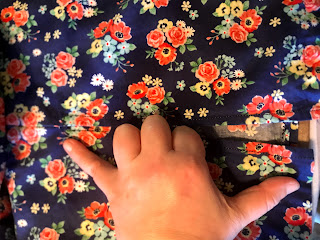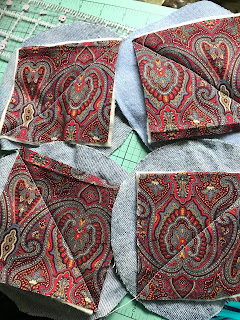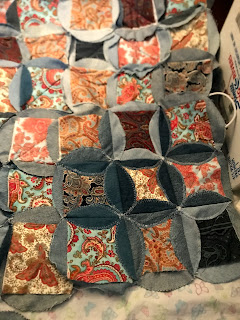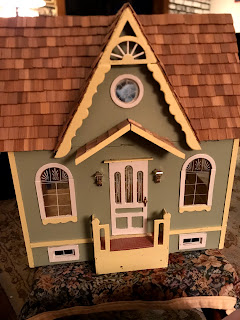Saturday, October 31, 2020
yoke cardigan
Saturday, October 17, 2020
The Larkin and Smith English gown(s)
I started these bad boys back in 2018 when I was nannying for a friend, who still has an amazing fabric stash for projects. (I'm more the person who says, ooo, I want that fabric for this specific project. She, on the other hand, just buys the fabric, and worries about the project later).
Part of my remuneration for watching her kids was yardage and yardage and yardage of a beautiful yellow and mauve linen stripe and a mauve worsted wool. I never knew wool could feel like this. It's not scratchy. It's wonderfully smooth. I've been watching Burnley and Trowbridge for another worsted, and I think I may need to purchase the Aurora lightweight stuffs - it's like the color of peach skin.
Anyway. I've been bungling my way through these gowns for the last two years. I got busy with work, with grad school, and then COVID happened, and suddenly I found myself with a lot more time on my hands than I anticipated. It didn't hurt that I was able to meet up with friends for a sewing weekend and ask questions about construction that frankly, I couldn't figure out from reading the instructions.They're mixed parts of hand and machine sewn - I did blind hems on the linen gown and petticoat so I could have one of the gowns for sure ready for the coming weekend.
Update: It's the end of January, and I'm almost done sewing the wool worsted! It looks like I made a mistake with the sleeves, which I have to go back and fix, but it's not a big deal. What is unfortunate is that I have these two finished gowns and no events to wear them to, thanks to COVID!
Saturday, August 29, 2020
Weather at work
I started a new job on Monday and we had this storm roll through on August 27th. This shelf cloud was incredible to watch forming!
Some sights from Quarantine
Tuesday, August 11, 2020
the easy peasy tank top dress
Materials you may or may not have on hand
Say a 40 inch waist, which means you add 20 inches to that for a total of 60". Which is roughly 1 and 2/3 yards of fabric. See, I practically did the math for you. There's also nothing saying that you couldn't use more yardage and have a fuller skirt, but I'm not sure why you'd want to? It's a giant tube, so it's not going to flair out at the bottom.
Some construction notes -
 - I wish I could have tried the tanks on ahead of time (dressing rooms closed, thanks COVID). I wouldn't have bothered with the green one, though it does do a better job of covering everything it's supposed to. The pink one not so much.
- I wish I could have tried the tanks on ahead of time (dressing rooms closed, thanks COVID). I wouldn't have bothered with the green one, though it does do a better job of covering everything it's supposed to. The pink one not so much.The lighting is horrible in this picture, but you can see there's a light colored stripe running around the front of my shoulder. That's where the tank doesn't cover my light pink bra. It's not just this bra, either, it's all of them.
For reference, I'm a 36F, and the tank is a 3X Time and Tru from Wal-Mart. I marked three inches above my natural waist on the tank (with a pin) for the skirt, which also happens to hit my bra band. For the skirt length, I measured my bra band to ankle length, and added about two and a half inches for seam allowance and hemming. Since you cut one of the selvage (woven side) edges off to get your length, I used the finished edge at the top to keep things neat, and hemmed the cut edge - it gave me an excuse to try the blind hem foot.
 - I took the extra step of finishing the inside of the pink floral gown by leaving a big seam allowance of the knit fabric, trimming down the print, and making a casing (French seam) out of the pink knit. On the outside, it looks like I have 1/4 inch elastic at the waist... but as you can see from the inside, it's really that small folded over casing, and three rounds of elastic thread keeping things snug but not too snug. I wore this pink gown to the hospital on surgery day with a little lightweight cardigan, and the waist band stayed up and out of the way of the incisions, which was the overall goal.
- I took the extra step of finishing the inside of the pink floral gown by leaving a big seam allowance of the knit fabric, trimming down the print, and making a casing (French seam) out of the pink knit. On the outside, it looks like I have 1/4 inch elastic at the waist... but as you can see from the inside, it's really that small folded over casing, and three rounds of elastic thread keeping things snug but not too snug. I wore this pink gown to the hospital on surgery day with a little lightweight cardigan, and the waist band stayed up and out of the way of the incisions, which was the overall goal.- The back seam of the dress is the only seam - aside from the bottom hem - that doesn't use the elastic thread in the bobbin. I wish I would have taken the five seconds to finish the raw edge of the back seam - it's just a nicer presentation, and it really is more comfortable to wear.
 The tutorial I followed said a vent for a maxi dress was optional.
The tutorial I followed said a vent for a maxi dress was optional.Hah.
Save yourself the trouble. Put in a vent.
It doesn't even have to be that long, I think the vent in this one is 10 inches at most? Just remember to mark how long you want the vent to come up from the raw hem edge, reinforce the top of the vent, and stitch the edges of the vent down. I did the back seam first, and back stitched at the top of the vent. I then clipped the seam allowance so that the vent edges were separate from the back seam and rolled them under, and I top stitched up one side and down the other, back stitching at the top of the vent. Remember how I said I was lazy? I should have finished the back seams while I was at it, and just reinforced the top of the vent while I had everything turned under. Alas.
Tuesday, August 4, 2020
gym-ish shorts
These shorts [for me, at least] fall into the category of Things-I-Can-Make-With-a-Yard-of-Fabric, or conversely 3/4 of a yard of this and half a yard of that. And some very rando bias tape. Something else I love about these shorts is that there is no pattern - shut the front door, I know! Here's the however because I can see you've already decided you don't want to bother without a paper pattern because anything without a paper pattern is too hard. If you have any kind of straight ruler, a measuring tape, a bowl, and either a few brown paper bags from TJ's or WF or a roll of wrapping paper, you, too, can do this. Pinky promise.
Some things to note:
If you're liking the shorts idea but don't really want your shorts to wrap around, check out this pattern from Purl Soho City Gym Shorts
I mashed up two patterns to do this; the instructions and pattern from a pair of shorts designed by Tara Miller and published in the Stitch Magazine originally and the measurement instructions for these Tap Pants [which I also have made]. I made the tap pants first, and then adjusted the tap pants pattern so that it had the lines I wanted for the gym shorts [tulip shorts, boudoir shorts, seriously, these things go by many names]. The Miller design wants you to cut out out the front fold over bit as two pieces, so that there is a side seam. If you follow the original, you can add pockets. Don't get me wrong, I love me some pockets. At this juncutre, I didn't want a side seam, especiallynot when I planned to use a solid for the back and sides where the seam would be obvious. The blue rose print would hide a side seam better.
Making the side panel and back panel into one is simple enough. If the pieces are already cut out, simply fold the seam allowance bit over (if you're the type to include a seam allowance in a paper pattern - I am, I never remember to put it back in!) and tape the edges together, or if you're feeling very bold and daring, lay the two pieces down together on the fabric with the edges lined up and pin them to the fabric to cut out the pieces. You make have made a pattern alignment mark, such as commercial patterns have notches so you know where to line things up. That should help.
And that's it! This doesn't really change the construction of the shorts, only that you've eliminated two side seams.
Tuesday, July 28, 2020
Rag quilts
My mother loves that first blanket but I'm not such a fan. Mom always wanted it to have a "more finished edge", but with it being a rag quilt, I wasn't sure what to tell her. It's not like you are supposed to bind the edges of them. I mean, I guess we could...
Fast forward to today. Or, rather, a few months ago... maybe longer. While trawling Pinterest, I saw another version of a denim rag quilt. This one was labeled a mock Cathedral Windows [and to be honest, I can't even find the pin now].
Eureka, I've figured out what I'm doing with the rest of the denim.
- Cut your squares and circles.
- Pay attention to your denim - as a twill, it has an obvious right/wrong side. With wrong sides facing, lay a fabric square on top of denim circle so that the corners of the square touch edges of the circle on all sides. If you're using batting squares, sandwich the batting square between the denim and the pretty fabric. Pin if you wish, and stitch down from corner to corner of the pretty fabric to keep things from shifting.
- Choose your own adventure - finish sewing all of the circles and squares in this manner, or begin to stitch the prepared patches together as you go. I don't recommend this if you choose to wing it, because then you may end up with a concentration of one kind of fabric in one section of the quilt, and it just looks awkward.
- Sewing the patches together -
Take two prepared circles, and lay them so that the right sides of the denim are together, lining up the straight edges of the squares. Make sure your quilting lines are going the direction you want them to, or don't. Pin if you wish. - Using the straight edge of the square as a guide, stitch along the edge of the square as close as you can without sewing the square down. Now, there should be two half-moon looking flaps of denim flopping around between the two squares.
- Fold the denim flaps down towards the pretty fabric so that they lay flat, press or pin, your choice. I used a zigzag stitch to sew down the flaps, as close to the edge of the denim as I could get.
- Repeat steps 5 -6, sewing together prepared circles and stitching down flaps. Eventually, you're going to get to the point where you have long seams and you're stitching down a lot of flaps at once - if you plan ahead, you can turn the project so that the flaps are sewn all at once.
- Once the desired size is reached, fold down the edge flaps of the project and sew down all flaps.
Sunday, July 12, 2020
quarantine quilts


Sunday, March 22, 2020
Quarantine, day 8?
Fine people, some of you are not in education. Some of you take vacations this time of year because 'rates are lower', or in the fall after tourist season, or whenever you bloody well please because your vacay time doesn't have to occur within a mandatory window of June, July, and August. With the exception of the one time I went to England in 2008, have not been captain of my own destiny enough to afford to go on a vacation anywhere other than my parent's house. Or the yearly encampments at Old Fort Niagara and Cook's Forest. Not exactly exotic, and always when I already have time off from school. This whole staycation taking place not over a holiday and not in the middle of summer is a revelation.
Holiday vacation is not a vacation. At least if you're the person partly responsible for making holiday festivities happen. It's a time and a half job. Holiday vacations aren't nice. This? Holy cow. THIS IS SO NICE. I HAVE A RESPONSIBILITY TO NO ONE TO MEET HOLIDAY EXPECTATIONS.
I sort of actually like being outdoors this time of year. Keep your sunscreen, beaches, relative humidity of 99%, and skin cancer. Right now, the outside temperatures are all over the place, 60 and sunny one day, 26 with a wind chill of 15 the next. Welcome to spring in my neck of the woods. But the world is coming alive out there. Our crocuses poked their heads up and have been nodding in the brisk breeze. Buds are preparing to burst on branches; the quince, the sassafras, the flowering almond, those weird bushes on the side of the house that we've never been able to properly identify. On alternate route home from picking up flea medication for the pets, my mother and I saw pussy willows. There's been nothing to stop anyone currently from sitting outside in their yard except the wind chill, which I fully plan to do, with a roaring fire in the brazier. I bought the thing, I may as well get some use out of it if events are going to continue to be canceled.
While I do have to stay on top of coursework, I have no intention of keeping myself parked in front of a computer terminal just so everything can be turned in ahead of time (though this isn't a terrible idea...) Because of the nature of my GA, I haven't had a proper break, even over Christmas, because we have to come in and work a high vigilance job anyway. And now we don't. Frankly, it's a relief. I don't feel like I'm vibrating or mentally numb anymore. When this whole thing was beginning to blow up, we were told that face-to-face classes would resume April 6th. Now face to face University and ecumenical activities have been canceled indefinitely. I'm okay with this.




























